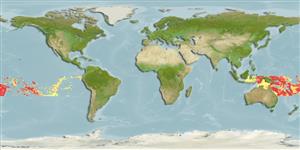Environment: milieu / climate zone / depth range / distribution range
Ecologie
marien; zoet water; brak water demersaal; katadroom (Ref. 51243); diepte 0 - 3000 m (Ref. 86942). Tropical; 1°S - 25°S
Pacific Ocean: Sulawesi, Indonesia to the Society Islands. Also recorded from Pitcairn (Ref. 9828).
Grootte / Gewicht / Leeftijd
Maturity: Lm ? range ? - ? cm
Max length : 100.0 cm TL mannelijk / geslacht onbekend; (Ref. 9828); 165.0 cm SL (female); max. gepubliceerd gewicht: 0.00 g
Wervels: 110 - 114. The only species that can be either variegated or plain-colored. Mottled individuals most closely resemble Anguilla celebensis and A. interioris in having broad, undivided tooth bands, but their ranges do not overlap. Plain-colored individuals most closely resemble A. japonica and A. borneensis, but those species both geographically distant. A. obscura is also plain-colored but has a shorter dorsal fin (Ref. 9828). The skin is grey to yellowish and more or less spotted with brown or black. It can be sometimes uniformly brownish red on the flanks and the back. The belly is white. Young specimens are grey and do not have spots (Ref.48622).
Found in rocky pools, often in coastal streams (Ref. 2847). No separate statistics available (Ref. 9828). The maximum weight (9,000 g) refers to the length (165 cm TL) of a female individual (Ref. 48622).
Levenscyclus en paargedrag
Maturities | Voortplanting | Spawnings | Egg(s) | Fecundities | Larven
Smith, D.G., 1999. Anguillidae. Freshwater eels. p. 1630-1636. In K.E. Carpenter and V.H. Niem (eds.) FAO species identification guide for fishery purposes. The living marine resources of the WCP. Vol. 3. Batoid fishes, chimaeras and bony fishes part 1 (Elopidae to Linophrynidae). FAO, Rome. (Ref. 9828)
Status op de Rode Lijst van het IUCN (Ref. 130435)
Gevaar voor de mens
Harmless
Gebruik door de mens
Visserij: commercieel
Tools
Speciale rapporten
Download XML
Internetbronnen
Estimates based on models
Preferred temperature (Ref.
123201): 3.7 - 9.6, mean 4.9 °C (based on 415 cells).
Fylogenetische diversiteitsindex (Ref.
82804): PD
50 = 0.5000 [Uniqueness, from 0.5 = low to 2.0 = high].
Bayesian length-weight: a=0.00076 (0.00037 - 0.00155), b=3.17 (3.00 - 3.34), in cm total length, based on LWR estimates for this Genus-body shape (Ref.
93245).
Trofisch niveau (Ref.
69278): 3.8 ±0.7 se; based on size and trophs of closest relatives
Weerstandsvermogen (Ref.
120179): Zeer laag, minimale populatieverdubbelingstijd meer dan 14 jaar (Preliminary K or Fecundity.).
Fishing Vulnerability (Ref.
59153): Very high vulnerability (90 of 100).
